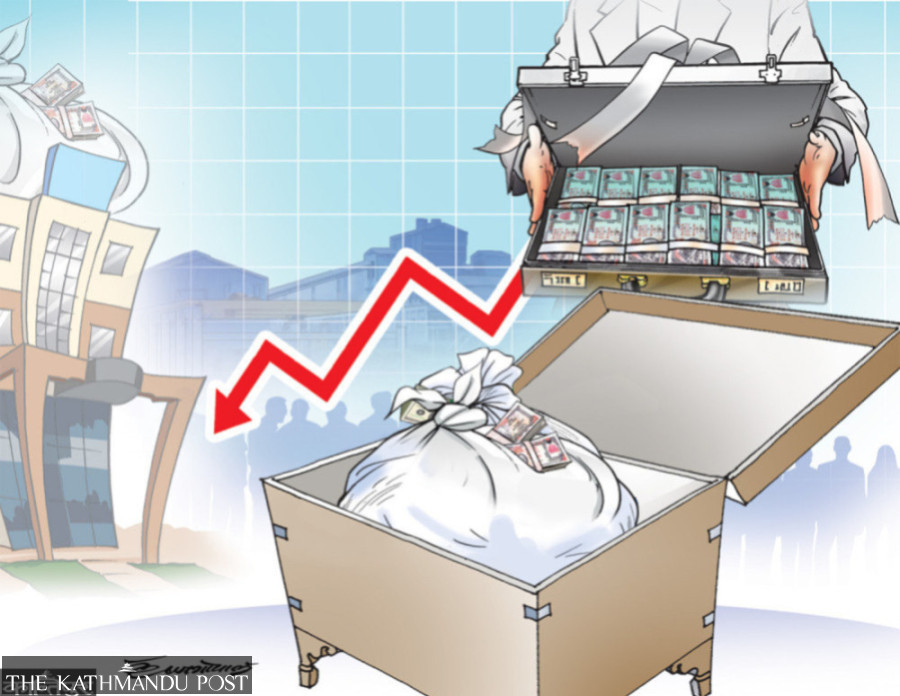Columns
Ailing institutions, stagnating economy
Political leadership shapes a nation’s fate, while institutional change is prerequisite for economic growth.
Durga Gautam
One of the most fundamental ways to characterise a nation’s approach to economic development is to look at the workings of its institutions. In simple terms, institutions are the incentive mechanisms embedded in the country’s formal and informal guidance systems. When these mechanisms fail to create useful incentives, and people lose trust in the system, they are reluctant to engage in productive activities. Historical evidence from large parts of South and Central Asia, Africa and Latin America shows that countries with ailing institutions suffer from economic stagnation and face recurring political conflicts.
Since institutions are largely path-dependent, in many cases, even historically significant uprisings are unlikely to bring meaningful institutional changes. For example, several South Asian countries, including Sri Lanka, Pakistan and Nepal witnessed some major shifts in their political landscapes in the recent past. The Sri Lankan civil war was fought for more than 25 years but only ended up with growing social injustice and futile governance, ultimately leading the country to bankruptcy. Pakistan continues to face a fragile economy along with multiple sources of internal and external conflicts, even though the country has institutionalised civilian government after a series of military coups and political assassinations.
Nepal’s experience
The decade-long Maoist insurgency in Nepal (1996-2006) finally descended to a soft landing after the rebels’ admittance to parliamentary democracy, but their commitment to good governance has faltered ever since, while the group’s political momentum has been fading away to date. With deeper intra-party conflicts and the decline of political power, the Maoists are virtually incapable of institutionalising the country’s socio-economic transformations—the Holy Grail of their revolt against the Establishment.
The failure of the Maoists’ political movement to bring broad-based social and economic changes is not an exception, however. The country’s first democratic government was formed with a two-thirds majority in 1959, led by visionary political figure BP Koirala, years after the success of the anti-Rana movement in 1950. Unfortunately, King Mahendra ended the democratic exercise in less than two years and ushered in 30 years of direct monarchical rule under the party-less Panchayat system.
The king’s removal of the democratically elected government paved the way for absolutism. Under this regime, citizens were granted no political rights or press freedom to demand transparency and accountability from public officials, and the prevailing court system could not act unbiasedly. Institutional appointments needed the monarch’s approval rather than a rigorous vetting process. No institutional reform bill could pass through the existing legislature without the palace’s consent.
Consequently, social exclusion deepened, ethnic marginalisation worsened and class and gender biases persisted. Besides, the Royal architecture failed to engage with international communities to build sustainable economic ties, import state-of-the-art technologies and expand the country’s foreign trade to match rapidly increasing globalisation. By pursuing import substitution industrialisation, the regime stood on the wrong side of history, isolating the nation from “badly needed” access to global capital markets. It was that period when most East Asian nations were promoting an “export-oriented” growth strategy.
Nepalis wanted a paradigm shift after the restoration of democracy in 1990. They hoped for wide-ranging social inclusion and equity, ethnic upliftment and rapid economic progress. However, people’s expectations turned into aggravated grievances due to frequent changes in government, widespread corruption and administrative mismanagement. There were no fundamental changes in the governance or workings of state institutions as many technocrats of the Panchayat regime continued to occupy key positions in the democratic system. Ordinary people found themselves trapped in a vicious circle of poverty and political instability. Economic hardship and political uncertainty intensified people’s grievances, on which Maoist insurgents capitalised and successfully articulated the people’s aspirations.
Institutions matter
In the words of economic historian Douglass North, “History matters not just because we can learn from the past, but because the present and the future are connected to the past by the continuity of a society’s institutions”. Individuals build their mental models based on the underlying rules of the game in society or the prevailing social norms and values deeply rooted in the institutional framework. Most importantly, individuals use their mental constructs while making choices and decisions.
The decision-making entities in society are ultimately organisations—for example, political bodies (political parties, the House of Representatives, a city council, a regulatory agency), economic bodies (firms, trade unions, cooperatives), social bodies (temples, clubs, athletic associations) and educational bodies (schools, universities, education boards). Since organisations are established for specific purposes, they face an evolving set of opportunities and constraints provided by the institutional framework. The future of a society depends on the nature of interactions between these organisations (the players) and the institutional framework (the rules). Douglass North views organisations as a major agent of institutional change, and in a competitive environment, when organisations emerge to accomplish their strategic objectives, society evolves.
Political leadership matters
A closer look at comparative statistics shows that dozens of countries in South and Central Asia, Africa and Latin America have stagnated and diverged from the rest of the world. According to an estimate, the divergence rate was 4.5 percent during the 1980s and 5 percent during the 1990s, indicating the mounting economic disparity between the stagnated least developed countries and the emerging ones, not to mention the enormous prosperity gap with industrial nations. Neither the forces of globalisation nor the aid package originating from the “Washington Consensus” rescued these countries from the stagnation trap. What went wrong?
Economist Daron Acemoglu’s historical evidence, among others, tells us the answer is leadership failure. The Democratic Republic of the Congo, the second largest country in Africa and a nation extremely rich in natural resources, has not only stagnated but virtually declined since its independence. The post-independence Congolese governments led by Mobutu and Laurent Kabila set the best examples of the worst economic outcomes resulting from terrible political leadership. Similar failed leadership and economic collapses have occurred in many other countries, such as Sierra Leone, Zimbabwe, Myanmar and Venezuela.
On the contrary, visionary leadership can create economic miracles. For example, Botswana is a landlocked country in Africa, like Zimbabwe, but because of its strong tribal institutions and farsighted policy reforms undertaken by its early elected leaders, the country has had the world’s fastest growth in per capita income since independence, averaging over 9 percent annual growth between 1966-99. As a result, Botswana ranks relatively high in the human development index (HDI), and its people enjoy better living standards. Botswana is the least corrupt country in Africa and consistently ranks higher in the democracy index than many European nations. Similar experiences of instrumental leadership and socio-economic transformations have been seen in several other countries, such as Singapore, Malaysia, Uruguay and South Korea.
These contrasting episodes of economic disasters and growth miracles offer a unique lesson—political leadership fundamentally shapes a nation’s destiny, while institutional change is an essential prerequisite for economic growth. Charismatic leaders have either successfully replaced their ailing institutions or removed them all. In some countries, they did it by reforming their constitutions, and in others, they did it by revolting against the government, but the status quo was not an option.




 18.12°C Kathmandu
18.12°C Kathmandu















